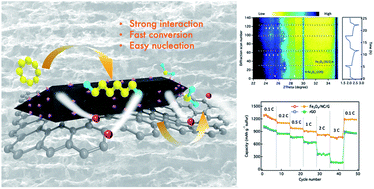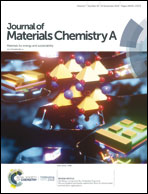Promoting polysulfide conversion by catalytic ternary Fe3O4/carbon/graphene composites with ordered microchannels for ultrahigh-rate lithium–sulfur batteries†
Abstract
As a promising energy storage system, lithium–sulfur (Li–S) batteries are attracting increasing attention but still limited by the sluggish reaction kinetics and shuttle effect caused by the dissolution of lithium polysulfides. Herein, a significant improvement of conversion kinetics and areal sulfur loading is achieved using an ordered microchannel graphene scaffold with incorporated catalytic Fe3O4 nanocrystals and porous carbon as a multifunctional sulfur host. The synergy between the polar catalytic Fe3O4 nanocrystals and porous carbon frameworks enables a strong polysulfide anchoring effect and a fast polysulfide conversion rate. Thus, the 3D ternary Fe3O4/porous carbon/graphene aerogel demonstrates an ultrahigh rate performance of 755 mA h g−1 at 3C and a high areal capacity of 6.24 mA h cm−2 at a sulfur loading of 7.7 mg cm−2. Moreover, the promoted reaction kinetics and reliable cyclability are revealed by the visible evolution of polysulfides using in situ X-ray diffraction (XRD), and the enhanced chemical anchoring of polysulfides is disclosed by density functional theory (DFT) calculations. This work provides a promising approach to develop multifunctional ordered porous aerogels with metal oxide nanocrystals for high-performance Li–S batteries, especially those which suffer from low sulfur loading and inferior rate performance.



 Please wait while we load your content...
Please wait while we load your content...